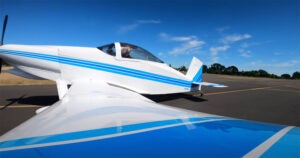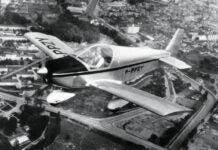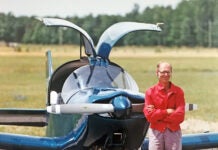
The first time I saw a Thorp T-18 it was like seeing a ghost. I recognized little details in the meticulously constructed side-by-side, two-place, all metal, low-wing homebuilt, including flush dimpled rivets and an intriguing flying tail (stabilator) Id not recalled seeing on a taildragger. I wanted to know more about its designer. The builder, an elderly gentleman, smiled mysteriously and said, Sure you know it. You fly Piper Cherokees, right? I laughed. As a flight instructor I had logged my fair share of time in Piper Cherokee 140s, Warriors, Archers and Arrows over the years. Well, he said, John Thorp had a hand in designing those, too.
In fact, Thorp, with his former employer, Lockheed, held the patent on the all-flying tail. Instead of a traditional horizontal stabilizer and elevator combination, a flying tails one-piece stabilator moves and changes its angle of attack to the airflow, giving the airplane comfortably light control forces throughout the pitch axis. Thorp realized that one could simultaneously enhance an aircrafts pitch responsiveness and pitch stability by allowing the horizontal stabilizer to be adjustable in angle of attack, moving opposite an anti-servo tab. This makes the entire horizontal tail surface a giant elevator, as opposed to the traditional fixed stabilizer and hinged elevator combination. The stabilator allowed for the horizontal tail surfaces to be as much as 25% smaller than traditional horizontal tail surfaces while having the same pitch effectiveness. Airplanes with stabilators have lighter tail feathers and require less material to construct. This all-flying tail became a Thorp signature on aircraft for the next 40 years.
I should not have been surprised. If you take the time to look behind the monikers of many FAA certified airplanes, you’ll find an Experimental aircraft at their core. The T-18 I was looking at was designed four decades ago with a non-folding wing and the NACA 63A-412 airfoil with a 50-inch chord. Equipped with a Lycoming O-360A1A, its cruising speed approached 190 mph, and many of these airplanes had maximum gross weights of 1800 to 1900 pounds, with empty weights between 1000 and 1200 pounds. Thats a pretty good useful load for a two-seater. Its stick forces were predictably light, and overall the T-18 reflected its designers singular goal: to create lightweight, efficient and pleasant-to-fly personal aircraft. Thats what Thorp was all about.
Where It All Began
John Willard Thorp (1912-1992) grew up in the house that his grandparents had built when they homesteaded in the San Joaquin Valley 50 years before his birth. The town of Lockeford, California, was his town, and a crazy cousin (his mothers words) lit the flying bug in Thorp early.
He told me a story of a local aviator who was related to the family. The guy would fly over the house, and his mother would say, No son of mine… says Richard Eklund, a Thorp protégé who’s now the owner of the Lockeford House, a bed-and-breakfast near Lodi, California. It’s the house that Thorp was raised and, in his final years, came home to. Eklund, a Thorp T-18 builder and owner, is the principal of Eklund Engineering, which still sells T-18 plans and sub-assembly kits (the rights to other Thorp designs rest with companies all over the world). He and his wife have created a small museum of Thorp memorabilia in the old barn on the property, and they are thrilled when guests at the inn are curious about the man who invented, designed or was a party to so many of the aircraft and aircraft accoutrements we take for granted today.
He learned to fly at what is now Lodi Field over on Highway 99, Eklund says. He was inventing from early on. In high school Thorp patented an interconnect linkage of spark retard, using levers and offsets so that when you pushed the throttle up, it retarded the spark on the Model A Ford engine. Eklund is pretty sure the sale of that patent to Ford Motor Company financed Thorps engineering education.
With good money in his pocket Thorp came out of his San Joaquin Valley hometown to the big city, Oakland, California, and settled in at the Boeing School of Aeronautics, in 1929. Within six years he’d logged time in dozens of aircraft and had hatched a few good ideas about how to build them, too.
The T-1 was no more than a design study for a two-place, fixed-wing airplane penciled in 1931. It was a low-wing, all metal, monocoque aircraft with a curious tail construction. Those were heady times at the Boeing School of Aeronautics in the early 1930s, and on the business side of things Thorp had the opportunity to aid in the design and subsequent manufacture of the worlds first passenger airliner, the Boeing 247. He probably spent time in Seattle, according to Eklund, but not more than six months passed before the native Californian was back in Oakland, teaching at the school. The weather probably brought him back, Eklund said, chuckling.
Productive Collaboration
The first few designs, the T-1 through T-6, were probably collaborations with builder Rudy Paulic, with whom Thorp formed the Rudy Paulic and John W. Thorp Aircraft Corporation, in 1940. The two had several ideas for light personal aircraft from 1935 to 1940, which coalesced into the Paulic XT-3 design project, an outgrowth of that original all-metal trainer. The XT-3 had revolutionary tricycle gear and a stabilator, which Thorp patented. But the timing was off, and the beginning of the war focused the designers on more pressing tasks such as the design and building of Lockheeds original P2 Neptune.
Thorp rose to the title of Assistant Preliminary Design Engineer at Lockheed during the war years, but it was his concepts for personal light aircraft that kept him up nights, doodling in the margins of his big-airplane plans. He tweaked his designs by swapping a 50-horsepower Franklin engine for a 65-hp Lycoming, and then swapping taildragger gear for the new style tricycle landing gear with extra long oleo struts. In the meantime, Lockheed built a single-seat adaptation of Thorps design and called it the Little Dipper. Lockheed test pilots loved to fly it, but the Army didn’t see the value in it and the company dropped it.
Going Solo
Thorp took things into his own hands after the war, creating the Thorp Aircraft Corporation with nine employees. On August 15, 1946, he flew a prototype, NX-91301, from the Van Nuys Airport. It was the original SkySkooter. Meant for the post-war boom predicted by every aircraft manufacturer (think of all those pilots coming back from the war and the airplanes theyd want to fly), the SkySkooter was the first airplane that was going to be economical enough for anyone to own and fly. Well, thats what Thorp hoped. But production and certification bogged down, and by the time the SkySkooter was ready for sale at $2000, the boom, or what there was of it, was over, and there simply were not any buyers.
Not to be defeated, Thorp brought the design to Fletcher Aviation Corporation of California, and with Wendell S. Fletcher developed it into the FD 25 Defender, a diminutive ground attack aircraft. While the FD 25 Defender may never have done much ground attacking, its agricultural derivative, the FU 24, was sold to New Zealand, and then to the rest of Asia as a crop duster. The airplane was fitted with a 225-hp Continental engine, but over the years it has been modified to run with 240, 260, 285, 300 and even 400 hp. In Asia today you can find Fletchers equipped with a 550-hp turbine up front!
Despite the airframes success as a crop duster, Thorp persisted with the idea that the SkySkooter would make the perfect runabout airplane. In the 1950s he re-dubbed it the T-111 and, working on contract with Piper, went about developing it to go head-to-head with the Cessna 150. But nothing really came of that. The airplane did remain available through plans and as a kit from John, and then through succeeding companies in the 1980s. Its powerplant was swapped several times. Originally conceived with a Franklin 50-hp engine, it never flew with one. By the time the design matured enough to be built, it sported first a 65-hp, and then a 75-hp Lycoming engine.
While Piper dropped its plans for the SkySkooter, Thorps affection for the design never faltered. He revived the airplane as a kitbuilt machine in the 1960s, this time as the T-211, with a 100-hp Continental O-200. This is where things stood when IndUS Aviation bought the rights to the FAA Part 23 certified version. The company currently manufactures it in Bangalore, India, and ships both kits and certified aircraft to Dallas Executive Airport, where the certified aircraft are assembled for sale as Light Sport Aircraft, and where a builder-assist facility helps first-timers get a leg up on their Experimental versions.
Thorp continued on contract with Piper, despite the demise of the SkySkooter. He helped with speed modifications on the Comanche series of aircraft, and was a principal designer, with Karl Bergey and Fred Weick, on the Piper Cherokee. The Cherokee was conceived as a less expensive alternative to the Comanche, with lower manufacturing and parts costs (though some later Cherokees also featured retractable gear and a constant-speed propeller). It was to compete with the Cessna 172.
Birth of the T-18
During the 1960s Thorp created the T-18, perhaps the most popular of all of the homebuilt aircraft he conceived. The two-place machine began its life with an open cockpit, no cowling and a converted Lycoming O-290G ground power engine to pull it through the air. It matured quickly on Thorps drawing board to a high-performance design with a pressure cowl, canopy and slotted flaps. The T-18 can use any of the Lycoming engines in the following series: O-290, 320, 340 and 360. The design retained the taildragger configuration, with strong A-frame main landing gear made of 4130 steel tubing that attaches to the fuselage at three points for ruggedness and simplicity. Its wings can be created from 0.025 or 0.032-inch 2024 T3 Alclad aluminum, wrapped trailing edge to trailing edge with no overlap.
One of the attributes of Thorps designs that was revolutionary for its time was the matched-hole drilling and assembly process. Requiring no jigs or complex arrangements for an airplane to come together, this has likely been key to the designs longevity in a tough marketplace. Thorp aircraft come together much like an Erector set: Pre-punched parts are matched up and Clecoed together so that they can be easily riveted, and large assemblies can be made in no time. Any metal aircraft kit builder will tell you that pre-punched matched-hole aluminum simplifies the build process and saves time.
I call it hole-coordination template technique, says Eklund, who now sells the plans and sub-assembly kits for the T-18 (there are other vendors who sell modified versions, including plans for folding wings, a different airfoil and a wider fuselage). There are so few parts. So little to machine. For example, the fuselage side skins are cut from one 5×15-foot sheet of aluminum, he says. Everything he designed was about as efficient as he could make it for the particular mission. Thorp honed it down to the basics.
The payoff for that efficiency was big. Don Taylor, a T-18 builder, used his airplane to fly around the world, and then from Pole to Pole, becoming the first to do so in a homebuilt airplane. His T-18 is now housed at the EAA Museum in Oshkosh, Wisconsin.
The 1960s found Thorp working on other projects as well. Eklund met him at Whiteman Field, in the Los Angeles basin, while Thorp was working on a project for Hiller helicopters. The relationship grew while Eklund was in college and the military. He helped while Thorp was creating the Volpar trigear conversion for the surplus military C-45s and civilian Beech 18s that were prone to ground looping as taildraggers. The Beech factory eventually purchased the Volpar trigear conversion, and the last Beech 18s off the assembly line were all trigear aircraft.
Eklund and Thorp spent a lot of time together during the 1970s and 1980s, and Eklund watched as Thorp was brought in on projects such as the Derringer, a sophisticated twin-engine aircraft that used chem-milled stretched skins on the fuselage.
It embodies what John called the low speed or poor mans area rule for wing-to-fuselage juncture, Eklund said. George Wing, inventor of the Hi-shear rivet [first used in the P51-C fighter], was a SkySkooter owner. He apparently saw drawings of a twin-engine Skooter (T-17) on Johns drafting table and hired John to do the preliminary design for a high-performance, two-place twin. The Derringer turned out to be an expensive airframe, and Eklund believes that only five airplanes were ever built.
Winding Down
Thorp retired in 1985, and took the aircraft designs he still held the rights for off the market. He moved back to Lockeford, the family homestead, and tasked himself with restoring the 100-year-old buildings and gardens with his wife. That didn’t mean that he didn’t get around, traveling mostly in his own personal runabout, a SkySkooter.
As he aged, he and Eklund stayed in touch, often meeting at fly-ins. When Thorp passed away in 1992 of complications from Alzheimers, Eklund and his wife, Lani, at the invitation of Thorps wife, came west and continued the homestead restoration, eventually taking over the property upon Kays death.
The barn on the property is more than just a historical spot. Eklund, an engineer by training, also sells T-18 plans and pre-manufactured subassemblies from there, ensuring that Thorps signature airplane lives on in the numerous garages, outbuildings and shops of homebuilders all over the world. I just sold a set of plans to someone in Sweden last week, he said, smiling.
Eklund flies to AirVenture religiously, first in his own SkySkooter, and now in the T-18 he built. The luncheons we have for T-18 builders draw as many as 100 people, he said, proudly. In any given year some 20 to 50 airplanes rendezvous at the event.
The IndUS Thorpedo, every version of the T-18, the Piper Cherokee line, and even the most advanced fighter aircraft in the U.S. fleet all owe some key component, or their entire design, to the doodling of a young engineer that Boeing Aircraft trained to make big airplanes. His were more than just good ideas. They flew.













